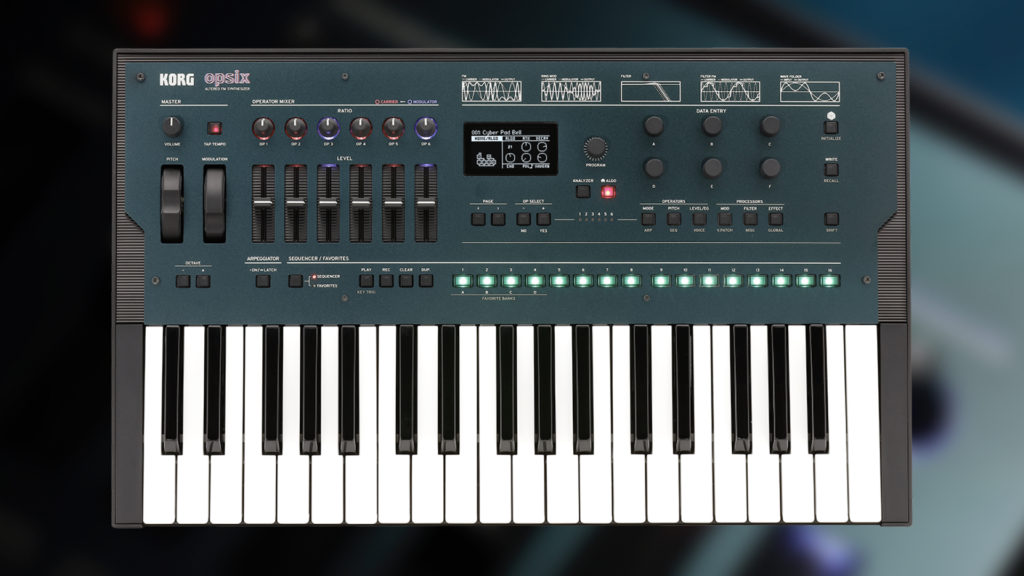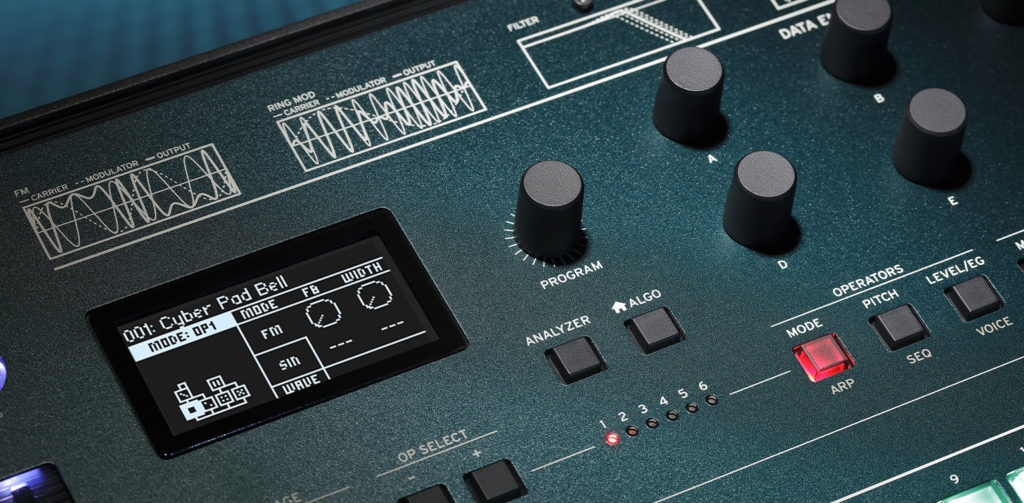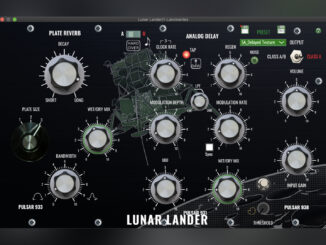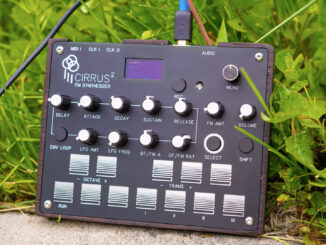Korg OPSIX review: a 6-operator FM Synthesizer of the next generation that breaks new ground in FM synthesis by making it more accessible, playable and powerful.
1983, Yamaha released the DX7, a Synthesizer that became quickly a huge success. It was the first commercially successful digital synth and is one of the best-selling in history. What this instrument did differently is old news today. It used a digital FM synthesis engine that gave musicians the opportunity to build new types of sounds. Very organic timbres that are reminiscent of acoustic instruments. These were difficult or impossible to recreate with instruments from the early 1980s. It was the time of the analog synths.
This fascination for FM synthesis had a downside that continues to this day. DX-style is complex and programming is relatively unfriendly. Lots of menus with deep functions that had the charm of maths functions from the school. 37 years after this important event, another well-known Japanese company is tackling the topic.
With the release of the OPSIX, Korg tries to bring the classic DX-7 synthesis into the modern by making it much more hands-on, logical, and versatile. In this review, I am looking into the question of whether Korg has managed this with the OPSIX.
Build Quality
The OPSIX is part of the new Korg digital Synthesizer family. The device has a lot in common with the first release, the Wavestate. Later this year (2021) there will be the modwave, a new wavetable Synthesizer. The similarities can be seen on the outside as on the inside. The most striking point is the design. The case is made of plastic and is very light (2,9kg), unusually light for such a mid-priced Synthesizer.
Personally, I prefer synths that are a little bit heavier. This would also be good for the OPSIX. In practice, it feels good when it’s on your table/stand, but when you pick it up it feels cheap to me because of the plastic case. The built-in knobs and sliders feel good and valuable. Nothing to complain about. However, this does not apply to the keyboard.
Unfortunately, Korg has installed the same keyboard as in the Wavestate, which has already been criticized by many. No aftertouch and not high quality. I’m not a professional keyboarder at all but it feels very spongy. For example, the Modal Electronics Argon8 & Cobalt8 use Fatar keybeds that feel and play much better. They saved in the wrong place. A desktop version would be a welcome step here.
Hands-On Interface
The Korg developers have put a lot of thought into how to make FM synthesis more attractive and logical for musicians, both visually and operationally. Spoiler, they did that successfully.
OPSIX is a 6-operator FM Synthesizer with up to 32 voices but is by no means a clone of the Yamaha DX-7. It’s Korg’s own take on FM synthesis. This already starts with the interface. Away from cryptical, uninspiring operation, towards a hands-on color-coded interface. The latter is divided into three areas. The operator mixer, the screen, and six rotary knobs for the menu operation. The operator mixer on the left plays a big role and the most important one in my opinion. It decodes the DX synthesis by visualizing it.
Operator Layout
Each operator (6 in total) has its own knob for the ratio and a volume slider. No annoying menu diving, you have the essential parameters right in front of you. Korg has color-coded these knobs and faders nicely and they change the color depending on the selected algorithm. Pink the carriers, and blue the modulators. In this way, you can see which operation has which role, and it makes visible how the algorithm is structured. With a double click on the shift key, you can even set the synthesis form and waveform for each operator here. So no menu diving necessary.
In the test, I noticed that the operator matrix/mixer is also a very versatile performance tool. Great for making a sound more or less complex in seconds. These movements can also be recorded by the built-in sequencer.
Display & Knob Operation
The display is located right next to the matrix. It’s an OLED display, is small, could be bigger, but is super sharp. Below you have two menu buttons with which you can simply step through the menu system. Yes, there are menus but they do not cause headaches.
Next, you have the operator selection knob with 6 LEDs which are very helpful. With this, you can easily call up the settings for each operator. If you are in a setting like the pitch envelope you can do this for all six operators at the same time at the push of a button without leaving this setting. Is very efficient and practical.
On the right side, you have the main buttons for the engine. Two sections are available, one for the operators and the other with parameters that apply to the whole sound. That’s very clever and gives you more of the feeling of programming a classic subtractive synth. Each button is assigned twice here, the second function can be reached with the shift key. These are shortcuts to a different menu area such as filters, effects, sequencer, etc. Each menu also has several pages that can be browsed effortlessly with the page button. There are menus, yes, but the layout is logical and straightforward.
The interface is a big highlight. Korg managed to visualize the engine in such a way that it is fun to build sounds. It doesn’t make FM synthesis easier, but it does make it easier to understand.
Altered FM Engine
The interface received a lot of praise. It is a true highlight, but the engine also has a lot to offer, and yes Korg wouldn’t be Korg if they didn’t give the classic FM synthesis concept a fresh touch. The core has 6 operators (up to 32 voice) who can communicate internally using 40 different algorithms. That’s 8 more than in the Yamaha DX-7. Then, you can design user algorithms in the device leading to infinite possibilities. Somewhat inspired, of course, on the Yamaha SY-77, which already had it.
Programming your own algorithms is a bit fiddly, but it is a massive sound design tool. FM lovers will have a lot of fun. What distinguishes the OPSIX from any classic FM synthesizer, however, is the flexibility in the operator modulation. For each operator, you can select the synthesis in which way the signal is modulated. This ranges from FM, ring mod, filter, filter FM, to wavefolder. That’s innovative and the wildest combinations are possible.
More Than Sine Waves
Korg doesn’t limit this to classic sine waves. They give the OPSIX 23 different waveforms, from simple to complex, which make the engine even more versatile and complex. In practice, it’s a lot of fun not only to play with sines. It gives you a completely different look at FM synthesis. In addition, there are numerous features and parameters for each operator that are known from other FM synths such as the obligatory envelope generator and more.
In the test I built patches that sound like a virtual analog Synthesizer in the first operators, but if you mix the others using FM, you get a nice mix of both. The warm thing we love about “analog” and the bizzare, cold textures from FM. It also enables you to build sounds that sound like a Buchla synthesizer, for this you only have to use the wavefolder, preferably with sine waves.
OPSIX & Yamaha DX7 Patches?!
Many of you have asked if the OPSIX can also read DX-7 patches. The answer is yes. You can not load individual patches via USB – SysEx, but banks with 32 patches each. Tip: use a software editor like the Dexed Synthesizer plugin and built your custom patch banks. A video tutorial on how to transfer these is available on the channel. The patches sound very close to the original DX-7, but not exactly. This is due to the other envelopes in the operators but also to the converter.
But Korg has come up with a clever idea. The sine waves are available in different resolutions like the 12-bit variant that can be found in the DX-7. In this way, differences in the analog converter can be compensated a bit.
Filters & Effects
Once the operators have been set, all signals run into different synthesis blocks that are responsible for the entire sound. The first block is a digital filter section that features different analog-style filters. It offers authentic emulations of the characterful, gritty MS-20 lowpass/high pass filters, to the powerful yet soft Polysix lowpass as well as many others. These sound top notch to me and are also available in the operator synthesis section. So you can filter the operator sound already in the core. Even if it goes against the tradition of FM, filters in FM are a lot of fun and enable many new sounds.
After the filter, the sound goes into a 3-slot multi-effects processor. 30 different effects are available including beautiful, lush reverbs, deep delays , or every distinctive ones like rotary speaker emulation, grain shifters, and more. It also ships with a shimmering reverb for ultimate ambient sounds.
I can clearly say that Korg masters effects. The Minilogue xd already had big effects, and yes, also the OPSIX. I didn’t find a bad effect, even the distortion sounds great and rich. Perfect to add more distorted harmonics and crunch to your sounds.
Modulation
On the modulation side, the OPSIX is anything but weak. Besides the operator modulation options, you have 3 LFOs, and 3 envelopes for the entire voice that form the core of the modulation engine. The envelopes are very classic ADSR type envelopes but have the ability to adjust the curve from linear to exponential and everything between what makes them flexible. The LFOs go far deeper.
Three LFOs are onboard, each with 23 different shapes to choose from. From classic saw, sine, square up to stepped ones or random. They also have very useful functions like key-sync, phase or fade in function.So the LFO fades not instantly but for example after some seconds. That’s great if you want to create evolving sounds or timbres. The modulators can either be routed directly in the respective blocks (filter …) or in the 12 slot mod matrix to the desired parameter.
Other modulators are also hidden here including velocity, MIDI CC, or polyphonic aftertouch. Powerful is that you can modulate almost every parameter, including those of the effects.
Arpeggiator & Sequencer
The built-in arpeggiator is relatively simple and offers classic patterns.No criticism, but a kind of intelligent arpeggiator as you can find it with Roland, would certainly have been exciting here too. The sequencer has only 16 steps which is a bit limited for such an innovative synth from 2020. But we have our beloved motion sequencer on board with 6 lanes with which you can put any parameter in deep motion. More precisely, you can record up to 6 parameters with fully customizable curves. Nice is that you can also program the arpeggiator intro the sequencer for eve more complex compositions.
On top, Korg has also given the OPSIX a randomizer either for all parameters or only for certain. The randomization function is a nice extra feature, but more or less a gimmick to me. The result are more useful if you apply it to the filter or effects. As with the arpeggiator, some AI or something would not have hurt that.
The instrument ships with 500 factory sounds in the straightforward browser where you can save 250 of your own sounds. I would have been happy to have more space for own sounds. .The presets give you a good first overview of the sound possibilities. From classic FM (acoustically imitating sounds…) to ordered chaos designed by Richard Devine, there is a lot to discover. Favorites can also be stored in 4 banks with 16 patches which you can call up with the buttons of the sequencer.
Summary
All in all, the OPSIX is a beautiful instrument. With its user-friendly and hands-on interface, new synthesis methods, and many creative extras make the opsix a contemporary FM Synthesizer. Not a Yamaha DX-7 clone but an extraction of the iconic FM synthesis idea taken into the present. Classically cold like a DX-7 or a fatter like a virtual analog synth. Opsix can do both. Custom algorithms, freely selectable synthesis per operator, built-in filters, excellent effects make the opsix a much more versatile synth than its FM competition. Its unique selling point is the interface that makes FM synthesis clearly more accessible, hands-on, and more understandable. There are still menus but everything is much simpler and logical.
The built-in keyboard is, however, a disappointment. It’s spongy, doesn’t feel great, and has no aftertouch. No aftertouch on an almost 800€ keyboard, why Korg? Synthesizers like the Modal Cobalt8 show that it’s possible. The same applies to the plastic case which polarizes the communities. Some don’t like the lightness, others do. I personally, like synthesizers that have weight. The opsix is lightweight and feels a little cheap. A little more weight would have done the device well. Knobs and sliders feel good. The display is a bit small but is crystal clear and easy to read.
For me, OPSIX is an FM synthesizer that casts FM under new spells. I think FM synthesis is coming back. The opsix is a nice example of how to modernize complicated FM technology from the past. It’s a game-changing device in FM synthesis.
Pro
- powerful, innovative FM synthesis engine
- more than sine waves
- versatile sound (from FM, virtual analog, west-coast up to wild mixtures)
- hands-on and accessible user interface
- top notch stereo effects
Neutral
- multi-timbral (preenFM3 with 4 layers)
- no USB-host port
Contra
- keybed with only velocity (no aftertouch)
- very light case
- 16-step squencer
Korg opsix is available now for 749€/$799 worldwide.
More information here: Korg
Available at our partners







Be the first to comment